2013 CHRYSLER TOWN AND COUNTRY coolant temperature
[x] Cancel search: coolant temperaturePage 625 of 699

CAUTION!(Continued)
•This vehicle has not been designed for use with
propylene glycol-based engine coolant (antifreeze).
Use of propylene glycol-based engine coolant (anti-
freeze) is not recommended.
Adding Coolant
Your vehicle has been built with an improved engine
coolant (OAT coolant conforming to MS-12106) that
allows extended maintenance intervals. This engine cool-
ant (antifreeze) can be used up to ten years or
150,000 miles (240,000 km) before replacement. To pre-
vent reducing this extended maintenance period, it is
important that you use the same engine coolant (OAT
coolant conforming to MS-12106) throughout the life of
your vehicle.
Please review these recommendations for using Organic
Additive Technology (OAT) engine coolant (antifreeze) that meets the requirements of Chrysler Material Stan-
dard MS-12106. When adding engine coolant (antifreeze):
•
We recommend using MOPAR® Antifreeze/Coolant
10 Year/150,000 Mile Formula OAT (Organic Additive
Technology) that meets the requirements of Chrysler
Material Standard MS-12106.
• Mix a minimum solution of 50% OAT engine coolant
that meets the requirements of Chrysler Material Stan-
dard MS-12106 and distilled water. Use higher concen-
trations (not to exceed 70%) if temperatures below
�34° F (�37° C) are anticipated.
• Use only high purity water such as distilled or deion-
ized water when mixing the water/engine coolant
(antifreeze) solution. The use of lower quality water
will reduce the amount of corrosion protection in the
engine cooling system.
7
MAINTAINING YOUR VEHICLE 623
Page 626 of 699
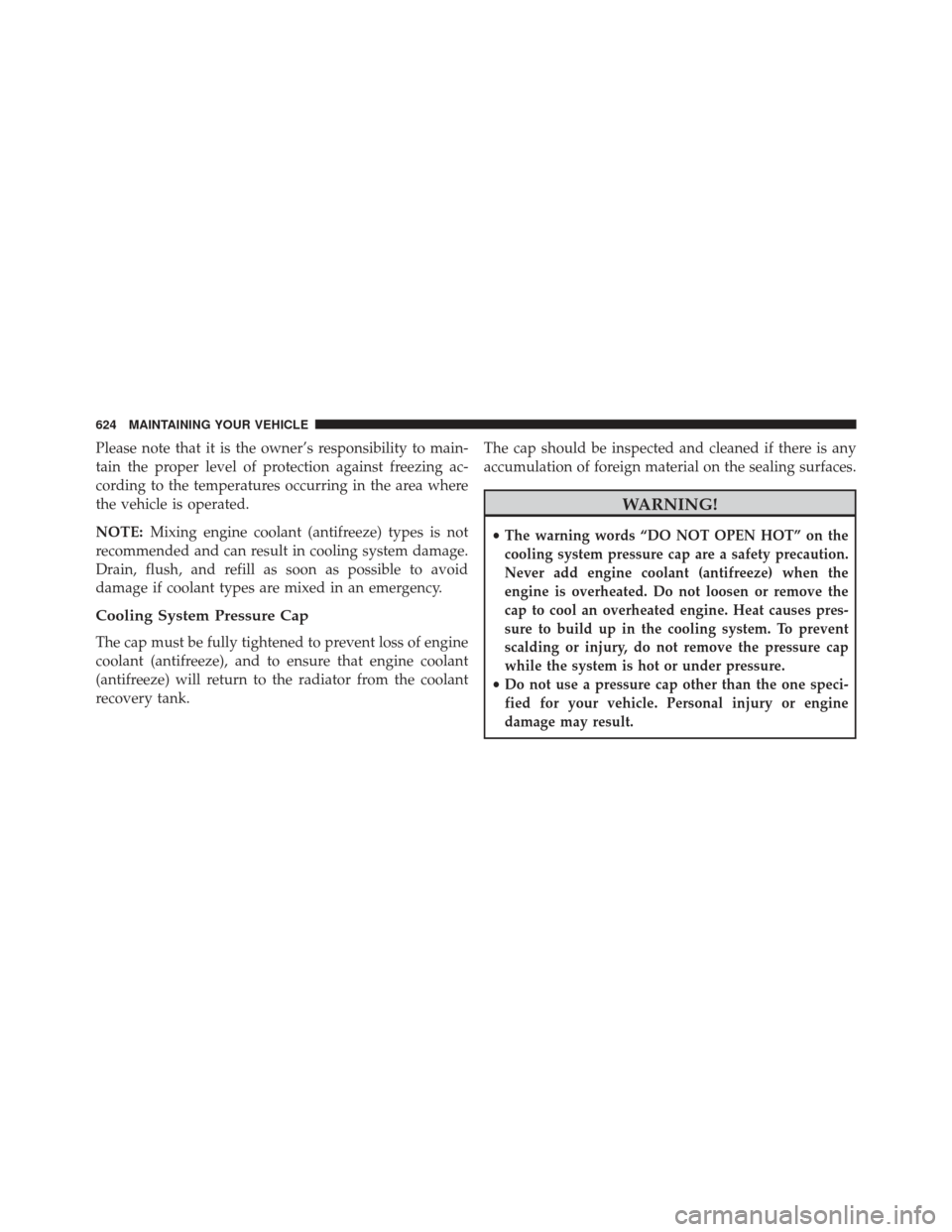
Please note that it is the owner’s responsibility to main-
tain the proper level of protection against freezing ac-
cording to the temperatures occurring in the area where
the vehicle is operated.
NOTE:Mixing engine coolant (antifreeze) types is not
recommended and can result in cooling system damage.
Drain, flush, and refill as soon as possible to avoid
damage if coolant types are mixed in an emergency.
Cooling System Pressure Cap
The cap must be fully tightened to prevent loss of engine
coolant (antifreeze), and to ensure that engine coolant
(antifreeze) will return to the radiator from the coolant
recovery tank. The cap should be inspected and cleaned if there is any
accumulation of foreign material on the sealing surfaces.
WARNING!
•The warning words “DO NOT OPEN HOT” on the
cooling system pressure cap are a safety precaution.
Never add engine coolant (antifreeze) when the
engine is overheated. Do not loosen or remove the
cap to cool an overheated engine. Heat causes pres-
sure to build up in the cooling system. To prevent
scalding or injury, do not remove the pressure cap
while the system is hot or under pressure.
•Do not use a pressure cap other than the one speci-
fied for your vehicle. Personal injury or engine
damage may result.
624 MAINTAINING YOUR VEHICLE
Page 627 of 699
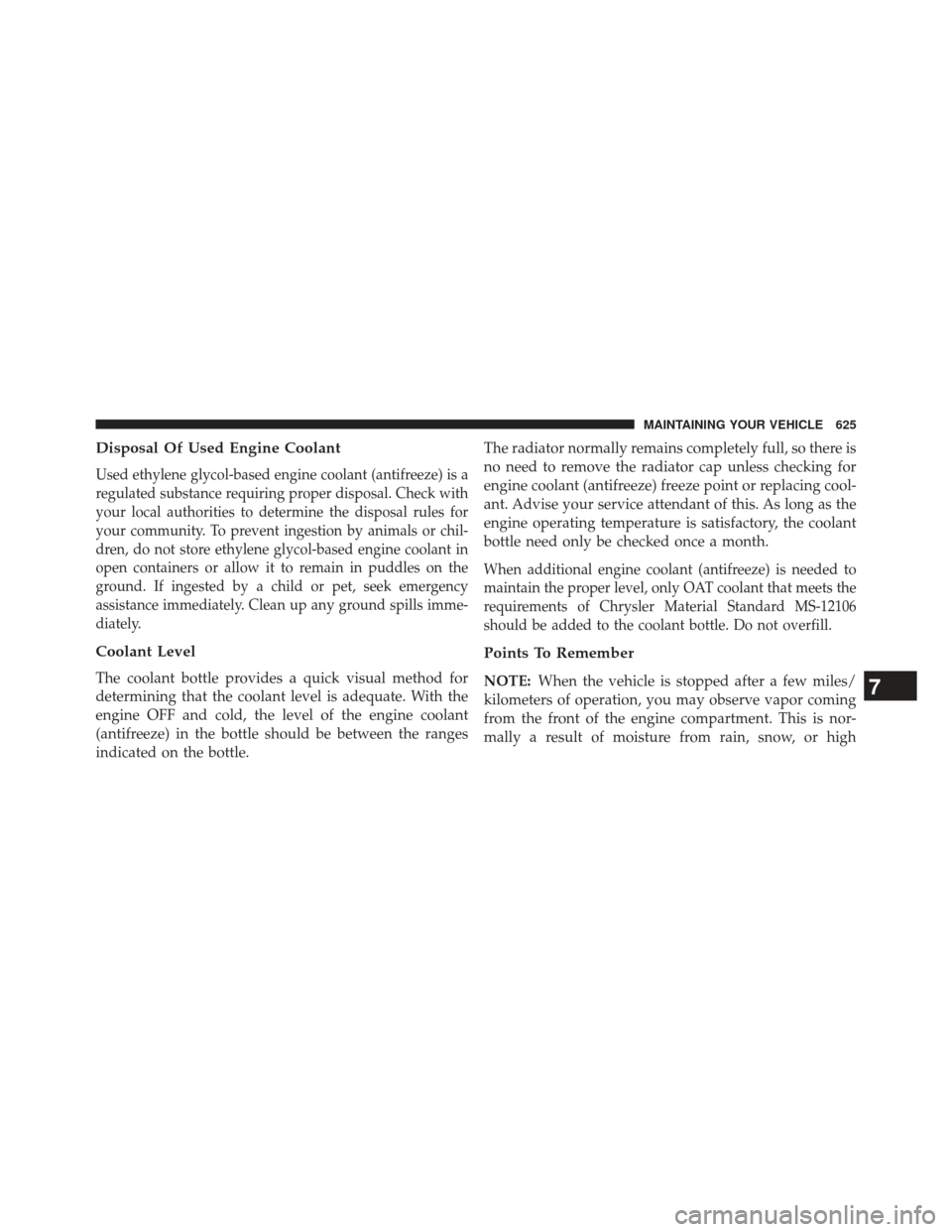
Disposal Of Used Engine Coolant
Used ethylene glycol-based engine coolant (antifreeze) is a
regulated substance requiring proper disposal. Check with
your local authorities to determine the disposal rules for
your community. To prevent ingestion by animals or chil-
dren, do not store ethylene glycol-based engine coolant in
open containers or allow it to remain in puddles on the
ground. If ingested by a child or pet, seek emergency
assistance immediately. Clean up any ground spills imme-
diately.
Coolant Level
The coolant bottle provides a quick visual method for
determining that the coolant level is adequate. With the
engine OFF and cold, the level of the engine coolant
(antifreeze) in the bottle should be between the ranges
indicated on the bottle.The radiator normally remains completely full, so there is
no need to remove the radiator cap unless checking for
engine coolant (antifreeze) freeze point or replacing cool-
ant. Advise your service attendant of this. As long as the
engine operating temperature is satisfactory, the coolant
bottle need only be checked once a month.
When additional engine coolant (antifreeze) is needed to
maintain the proper level, only OAT coolant that meets the
requirements of Chrysler Material Standard MS-12106
should be added to the coolant bottle. Do not overfill.
Points To Remember
NOTE:
When the vehicle is stopped after a few miles/
kilometers of operation, you may observe vapor coming
from the front of the engine compartment. This is nor-
mally a result of moisture from rain, snow, or high7
MAINTAINING YOUR VEHICLE 625
Page 680 of 699
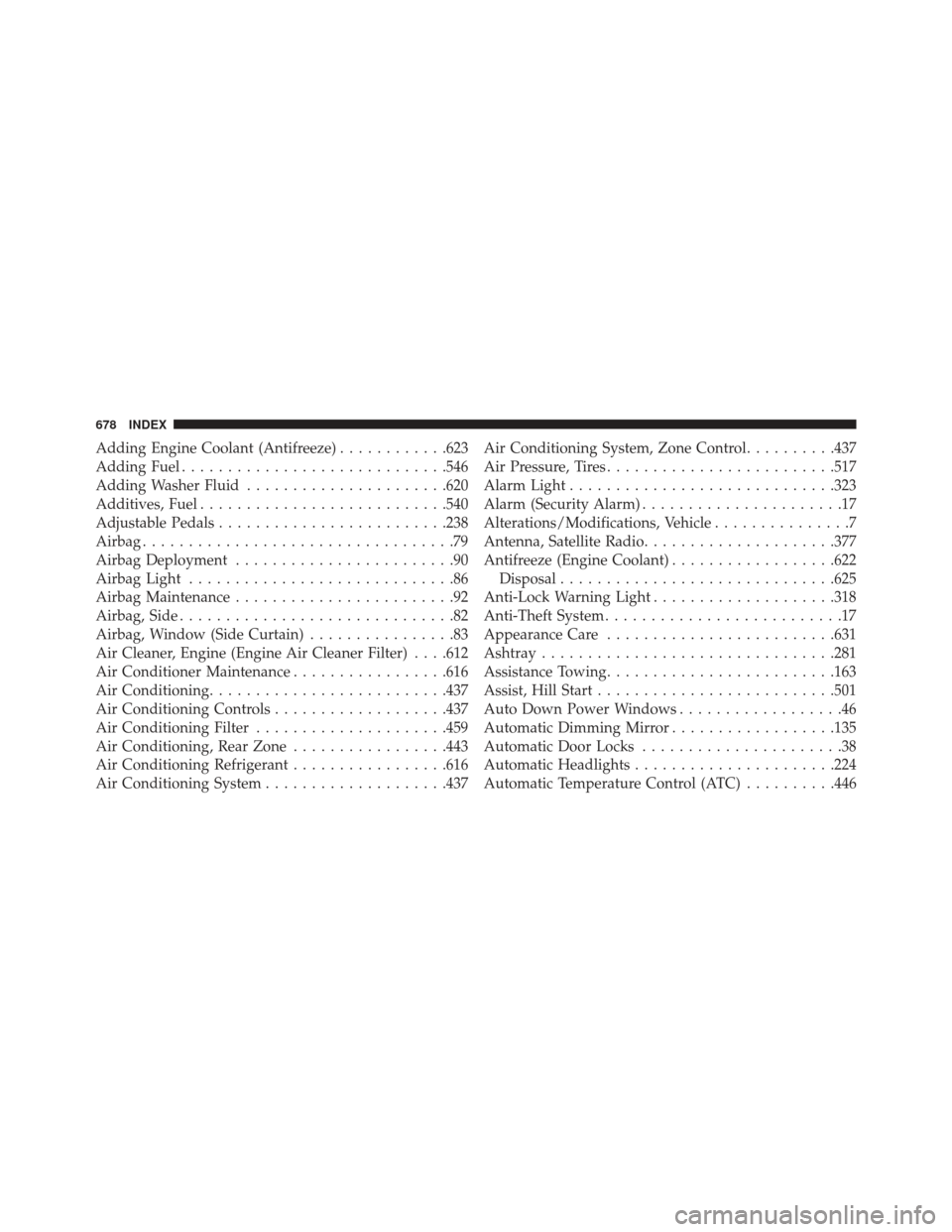
Adding Engine Coolant (Antifreeze)............623
Adding Fuel ............................ .546
Adding Washer Fluid ..................... .620
Additives, Fuel .......................... .540
Adjustable Pedals ........................ .238
Airbag ..................................79
Airbag Deployment ........................90
Airbag Light .............................86
Airbag Maintenance ........................92
Airbag, Side ..............................82
Airbag, Window (Side Curtain) ................83
Air Cleaner, Engine (Engine Air Cleaner Filter) . . . .612
Air Conditioner Maintenance .................616
Air Conditioning ......................... .437
Air Conditioning Controls ...................437
Air Conditioning Filter .....................459
Air Conditioning, Rear Zone .................443
Air Conditioning Refrigerant .................616
Air Conditioning System ....................437 Air Conditioning System, Zone Control
..........437
Air Pressure, Tires ........................ .517
Alarm Light ............................ .323
Alarm (Security Alarm) ......................17
Alterations/Modifications, Vehicle ...............7
Antenna, Satellite Radio .....................377
Antifreeze (Engine Coolant) ..................622
Disposal ............................. .625
Anti-Lock Warning Light ....................318
Anti-Theft System ..........................17
Appearance Care ........................ .631
Ashtray ............................... .281
Assistance Towing ........................ .163
Assist, Hill Start ......................... .501
Auto Down Power Windows ..................46
Automatic Dimming Mirror ..................135
Automatic Door Locks ......................38
Automatic Headlights ..................... .224
Automatic Temperature Control (ATC) ..........446
678 INDEX
Page 684 of 699
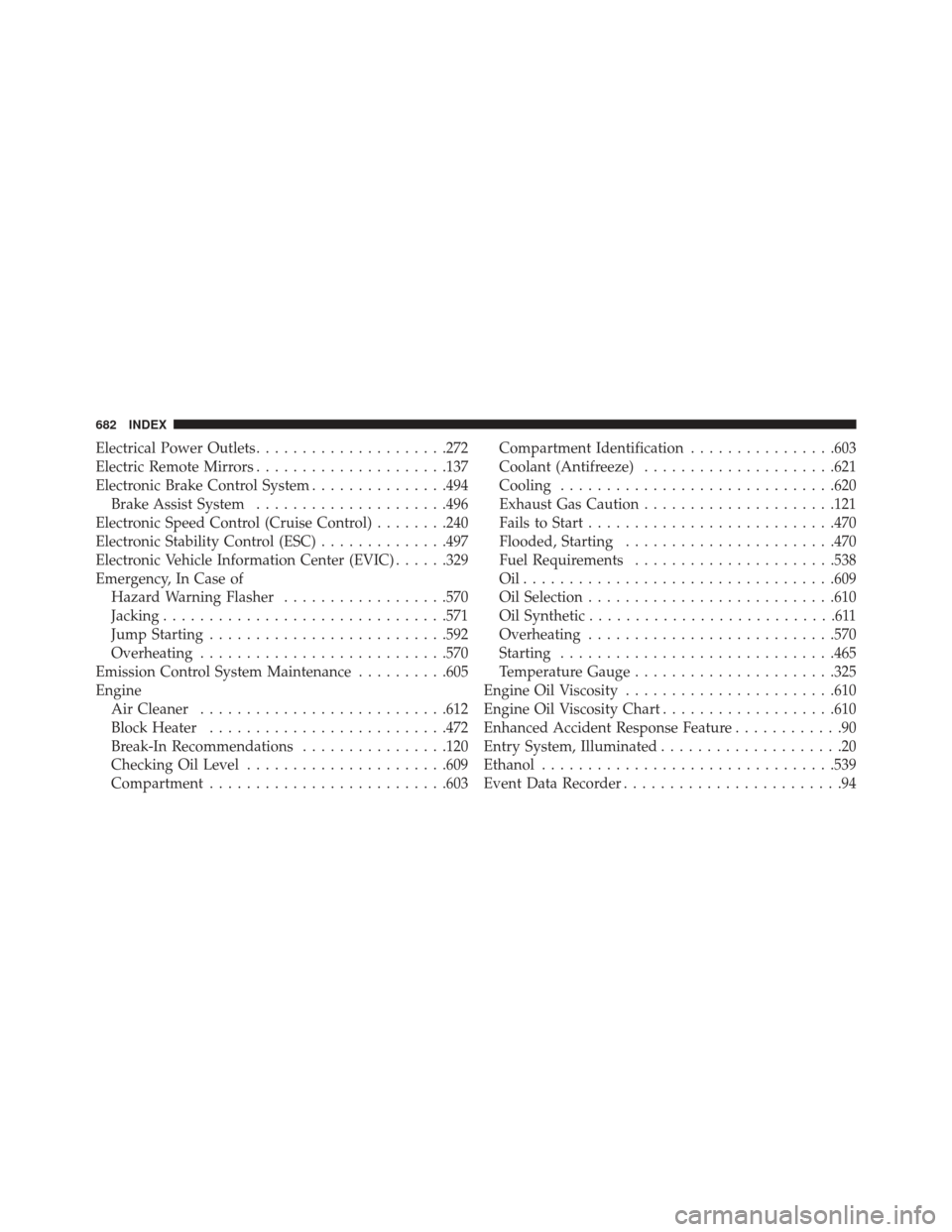
Electrical Power Outlets.....................272
Electric Remote Mirrors .....................137
Electronic Brake Control System ...............494
Brake Assist System .....................496
Electronic Speed Control (Cruise Control) ........240
Electronic Stability Control (ESC) ..............497
Electronic Vehicle Information Center (EVIC) ......329
Emergency, In Case of Hazard Warning Flasher ..................570
Jacking .............................. .571
Jump Starting ......................... .592
Overheating .......................... .570
Emission Control System Maintenance ..........605
Engine Air Cleaner .......................... .612
Block Heater ......................... .472
Break-In Recommendations ................120
Checking Oil Level ..................... .609
Compartment ......................... .603Compartment Identification
................603
Coolant (Antifreeze) .....................621
Cooling ............................. .620
Exhaust Gas Caution .....................121
Fails to Start .......................... .470
Flooded, Starting ...................... .470
Fuel Requirements ..................... .538
Oil................................. .609
Oil Selection .......................... .610
Oil Synthetic ...........................611
Overheating .......................... .570
Starting ............................. .465
Temperature Gauge ..................... .325
Engine Oil Viscosity ...................... .610
Engine Oil Viscosity Chart ...................610
Enhanced Accident Response Feature ............90
Entry System, Illuminated ....................20
Ethanol ............................... .539
Event
Data Recorder ........................94
682 INDEX
Page 686 of 699

Additives............................ .540
Clean Air ............................ .538
Conserving ........................... .340
Economy Mode ....................... .474
Ethanol ............................. .539
Filler Cap (Gas Cap) .....................323
Filler Door (Gas Cap) ....................323
Gasoline ............................. .538
Gauge .............................. .323
Light ............................... .326
Materials Added ....................... .540
Methanol ............................ .539
Octane Rating ......................... .538
Requirements ......................... .538
Saver Mode .......................... .340
Tank Capacity ......................... .653
Fuel, Flexible ........................... .542
Fueling ............................... .546
Fuel Optimizer .......................... .340Fuel Saver
............................. .340
Fuses ................................. .638
Garage Door Opener (HomeLink®) ............260
Gas Cap (Fuel Filler Cap) ...................546
Gasoline, Clean Air ....................... .538
Gasoline (Fuel) .......................... .538
Conserving ........................... .340
Gasoline, Reformulated .....................538
Gauges Coolant Temperature .....................325
Fuel ................................ .323
Speedometer ......................... .322
Tachometer ........................... .315
Gear Ranges ............................ .477
Gear Select Lever Override ..................596
General Information ........................17
Glass
Cleaning .......................... .636
Gross Axle Weight Rating ...................550
684 INDEX
Page 695 of 699
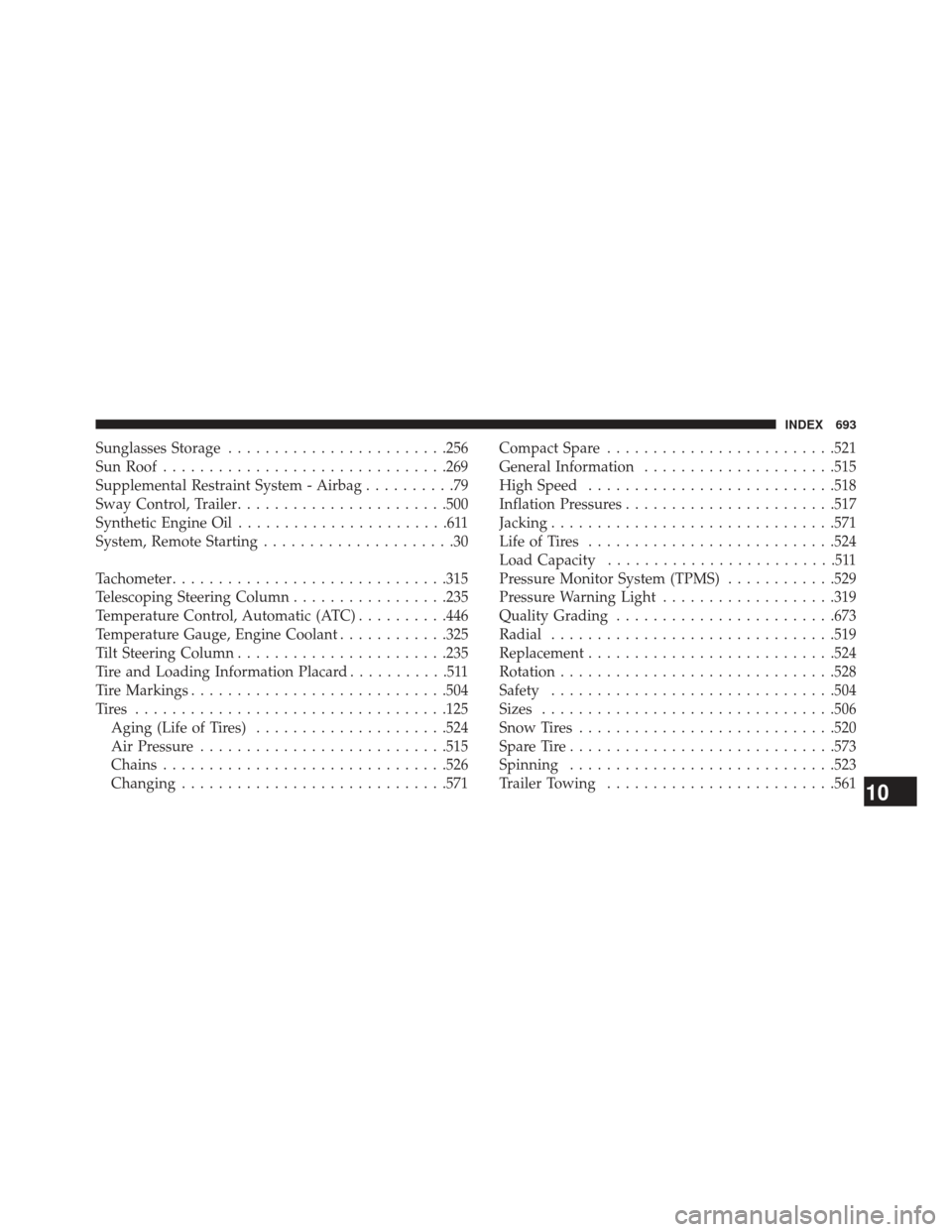
Sunglasses Storage....................... .256
Sun Roof .............................. .269
Supplemental Restraint System - Airbag ..........79
Sway Control, Trailer ...................... .500
Synthetic Engine Oil .......................611
System, Remote Starting .....................30
Tachometer ............................. .315
Telescoping Steering Column .................235
Temperature Control, Automatic (ATC) ..........446
Temperature Gauge, Engine Coolant ............325
Tilt Steering Column ...................... .235
Tire and Loading Information Placard ...........511
Tire Markings ........................... .504
Tires ................................. .125
Aging (Life of Tires) .....................524
Air Pressure .......................... .515
Chains .............................. .526
Changing ............................ .571Compact Spare
........................ .521
General Information .....................515
High Speed .......................... .518
Inflation Pressures ...................... .517
Jacking .............................. .571
Life of Tires .......................... .524
Load Capacity .........................511
Pressure Monitor System (TPMS) ............529
Pressure Warning Light ...................319
Quality Grading ....................... .673
Radial .............................. .519
Replacement .......................... .524
Rotation ............................. .528
Safety .............................. .504
Sizes ............................... .506
Snow Tires ........................... .520
Spare Tire ............................ .573
Spinning ............................ .523
T
railer Towing ........................ .561
10
INDEX 693